History
The state-owned Residenzgalerie provides a cross-section of painting from the 16th to the 19th centuries. It bears similarities with the extensive painting collection of Prince-Archbishop Hieronymus Colloredo, which was exhibited during his era (late 18th century) in rooms that are now the Residenzgalerie. After 1800, however, this collection was repeatedly plundered during the French Wars. In the age of the monarchy, many of the works were transferred from Salzburg to Vienna.
A new collection was proposed shortly after the First World War by a group of Salzburg artists, and the Residenzgalerie was opened in 1923. Apart from reinstating a permanent collection for Salzburg, the new gallery was also intended to be used by an art academy (never founded), encourage tourism, and provide a cultural attraction to go with the Salzburg Festival. [1]
The centrepiece of the Residenzgalerie is the Czernin Collection. This was first exhibited at the gallery in 1954, initially on loan and then bought outright between 1980 and 1991. Its paintings by 17th-century artists are principally Dutch, but also Italian, Spanish and French. Assembled between 1800 and 1845, the collection's original owner was Count Johann Rudolf Czernin von und zu Chudenitz, who studied law in Salzburg and was related to Archbishop Hieronymus Colloredo. Also important are a number of works from the collection of Friedrich Karl, Count Schönborn-Buchheim (1674–1746), featuring mostly Dutch and Italian artists of the 17th century, which the gallery acquired on permanent loan in 1956. [1]
Hieronymus, in English pronounced or, is the Latin form of the Ancient Greek name Ἱερώνυμος (Hierṓnymos), meaning "with a sacred name". It corresponds to the English given name Jerome.

David Teniers the Younger or David Teniers II was a Flemish Baroque painter, printmaker, draughtsman, miniaturist painter, staffage painter, copyist and art curator. He was an extremely versatile artist known for his prolific output. He was an innovator in a wide range of genres such as history painting, genre painting, landscape painting, portrait and still life. He is now best remembered as the leading Flemish genre painter of his day. Teniers is particularly known for developing the peasant genre, the tavern scene, pictures of collections and scenes with alchemists and physicians.

The Alte Pinakothek is an art museum located in the Kunstareal area in Munich, Germany. It is one of the oldest galleries in the world and houses a significant collection of Old Master paintings. The name Alte (Old) Pinakothek refers to the time period covered by the collection—from the fourteenth to the eighteenth century. The Neue Pinakothek, re-built in 1981, covers nineteenth-century art, and Pinakothek der Moderne, opened in 2002, exhibits modern art. All three galleries are part of the Bavarian State Painting Collections, an organization of the Free state of Bavaria.
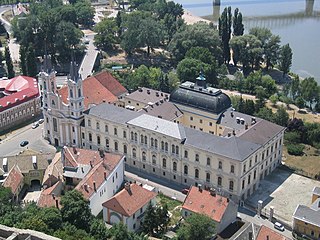
The Christian Museum is the largest ecclesiastical collection in Hungary; it conserves European and Hungarian works of art from the period between the 13th and 19th centuries.
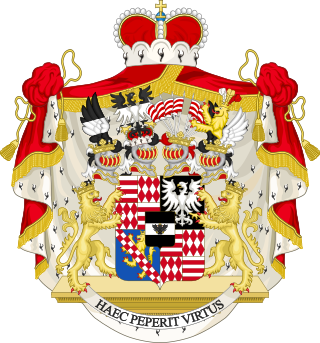
The House of Colloredo-Mansfeld is an originally Italian noble family of which a branch came to Austria in the late 16th century. There they were raised to barons in 1588, imperial counts in 1727 and imperial princes in 1763. They obtained Opočno Castle in the Kingdom of Bohemia in 1634 and acquired numerous further estates in Bohemia and Austria. In 1945 they were expropriated and expelled from the Czechoslovak Republic, but returned after 1990 and had parts of their former estates restituted.

The Art of Painting, also known as The Allegory of Painting, or Painter in his Studio, is a 17th-century oil on canvas painting by Dutch painter Johannes Vermeer. It is owned by the Austrian Republic and is on display in the Kunsthistorisches Museum in Vienna.

The Museu Nacional de Arte Antiga, also known in English as the National Museum of Ancient Art, is a Portuguese national art museum located in Lisbon. With over 40,000 items spanning a vast collection of painting, sculpture, goldware, furniture, textiles, ceramics, and prints, MNAA is one of the most visited museums in Portugal.

The National Gallery of Armenia is the largest art museum in Armenia. Located on Yerevan's Republic Square, the museum has one of the most prominent locations in the Armenian capital. The NGA houses significant collections of Russian and Western European art, and the world's largest collection of Armenian art. The museum had 65,000 visitors in 2005.

The Electorate of Salzburg, occasionally known as the Grand Duchy of Salzburg, was an electoral principality of the Holy Roman Empire from 1803–05, the short-lived successor state of the Prince-Archbishopric of Salzburg.

The Salzburg Residenz, also known as the Alte Residenz or Old Residence, is a palace located at Domplatz and Residenzplatz in the historic centre (Altstadt) of Salzburg, Austria. First mentioned about 1120, for centuries the Prince-Archbishops of Salzburg resided at the Residenz and used the palace to present and represent their political status. Today the Salzburg Residenz palace houses an art gallery, known as the Residenzgalerie, and is one of the most impressive attractions in the city.
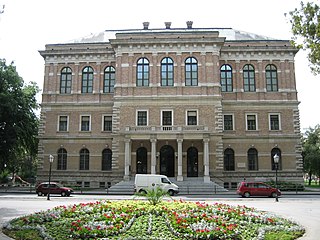
The Strossmayer Gallery of Old Masters is a fine art museum in Zagreb, Croatia exhibiting the collection donated to the city by Bishop Josip Juraj Strossmayer in 1884. Located at 11 Nikola Šubić Zrinski Square, it forms part of the Croatian Academy of Sciences and Arts.
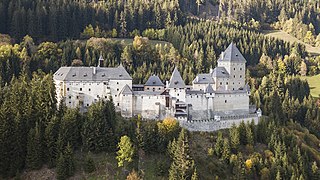
Moosham Castle is a medieval castle near Unternberg in the Lungau region of Salzburg, Austria. The spur castle is situated at a height of 1,079 metres (3,540 ft).
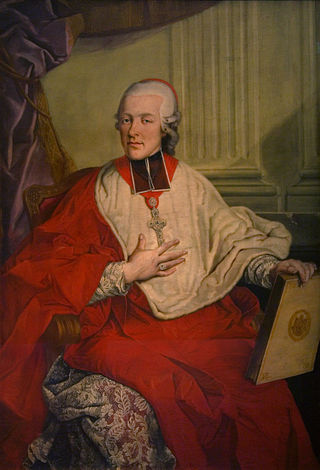
Hieronymus Joseph Franz de Paula Graf Colloredo von Wallsee und Melz was Prince-Bishop of Gurk from 1761 to 1772 and Prince-Archbishop of Salzburg from 1772 until 1803, when the prince-archbishopric was secularized. After secularization, Colloredo fled to Vienna and remained the non-resident archbishop of Salzburg, bereft of temporal power, until his death in 1812. He is most famously known as a patron and employer for Mozart.

Johann Rudolf Graf Czernin von und zu Chudenitz was an imperial and royal Austrian civil servant and theater director. He descended from the old Bohemian noble family Czernin von und zu Chudenitz. He was the son of Count Prokop Adalbert Czernin, who offered Mozart in 1776 a one year's rent, provided he would write some compositions for the Count's orchestra. His sister was Countess Antonie Lützow. His mother was the sister of Archbishop Colloredo, thus the Count was a nephew of the Salzburg Archbishop.

František Horčička (1776–1856) born in Prague June 29, 1776 and died in Prague April 5, 1856. Czech history and portrait painter. Along with painters Antonín Machek and František Tkadlík and sculptor Václav Prachner, he was among the first local artists to reimagine Neoclassicism using Romantic ideas. Horčička turned to painting in the private painter´s studio of Ludvík Kohl and after graduating from philosophy and law on the Charles University. In 1800 he entered new founded Academy of arts in Prague as a pupil of Josef Bergler.

Anton Hansch was an Austrian landscape painter.
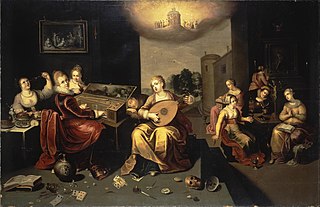
Hieronymus Francken the Younger or Hieronymus II was a Flemish painter and one of the most prominent members of the large Francken family of artists. Along with his brother Frans Francken II he played an important role in the development of new genres in Flemish art in the early 17th century. He was a prolific artist with a wide range who painted religious scenes, allegorical subjects, portraits, fruit pieces, genre scenes, architectural paintings and art galleries.

Het Noordbrabants Museum is an art museum in 's-Hertogenbosch, Netherlands.

Alphons Leopold Mielich was an Austrian painter noted for his orientalist scenes. He participated in a team responsible for documenting the frescoes in an Umayyad castle at Qasr Amra, including the famous Painting of the Six Kings and provided the illustrations for a published book on the findings, Kusejr 'Amra, published in 1907. He is also responsible for the destruction of most of the Painting of the Six Kings, as it was severely damaged when he attempted to forcibly relocate the paintings to Germany.
Andrew Carnduff Ritchie (1907–1978) was a Scottish-born American art historian specialising in British 18th-century sculpture, a professor, museum director and post-World War II 'Monuments Man'. He was the director of the Albright-Knox Art Gallery in Buffalo, N.Y., director of Painting and Sculpture at the Museum of Modern Art, and director of the Yale University Art Gallery.




















